The Moon Leaves Evening so We Eye Orion, Planets Persist, and Will Willie See His Shadow?

This terrific image of the Orion’s sword was taken on January 7, 2019 by Rick Foster of Markham, Ontario. Even binoculars will reveal that the central patch of light is the splendid Orion Nebula, also known as Messier 42. The grouping of bright stars at bottom right are “the Lost Jewel of Orion’s Sword”, particularly the magnitude 2.75 star named Nair al Saif, and sometimes called Hatysa, or Iota Orionis. Well above the Orion Nebula is the ghostly Running Man Nebula (Sh2-279), one the sky’s brightest reflection nebulas – composed of blue gas, darker dust, and stars in a package spanning 42 by 26 arc-minutes across. The area shown here covers about 2 finger widths of the sky.
Hello, late-January Stargazers!
Here are your Astronomy Skylights for the week of January 28th, 2024 by Chris Vaughan. Feel free to pass this along to your friends and send me your comments, questions, and suggested topics. You can also follow me on Twitter as @astrogeoguy! Unless otherwise noted, all times are expressed in Eastern Time. To subscribe to these emails please click this MailChimp link.
If you’d like me to bring my Digital Starlab portable inflatable planetarium to your school or other daytime or evening event, or deliver a session online, contact me through AstroGeo.ca, and we’ll tour the Universe, or the Earth’s interior, together! My book with John A. Read entitled 110 Things to See With a Telescope is a guide to viewing the deep sky objects in the Messier List – for both beginners and seasoned astronomers. DM me to order a signed copy!
This week the moon will clear out of the evening sky and move into morning. Along the way it will pose near some of spring’s stars. Those moonless evenings will let us appreciate the treats in Orion. Saturn and Mercury will soon be gone from view, but bright Venus and Jupiter persist. Finally, we look at the astronomy around Groundhog Day. Read on for your Skylights!
Groundhog Day
Friday morning, February 2 is Groundhog Day! A cloudy day for Wiarton Willie and Punxsutawney Phil supposedly augurs for an early spring. But why does it fall on February 2 each year? That date aligns with one of the four so-called cross-quarter days, which are the midpoints between the solstices and equinoxes. February 2 is about midway between the winter solstice and the vernal equinox – so we can expect the weather to start being more spring-like and less winter-like afterwards – no matter what your local groundhog or other burrowing rodent sees. If an early spring means clear night skies, astronomers are all for it!
You cannot merely divide our 365.25-day year into four 91.3-day-long seasons and then count half that many days past each equinox or solstice to reach the cross-quarter points. Planets with elliptical orbits move faster when they are closer to the sun and slower when they are farther away. Since Earth is moving more slowly at aphelion in early July, summer in the Northern Hemisphere are about five days longer than winter. And winters are a couple of days shorter than 91.3. The timing of solstices and equinoxes can vary by 18 hours, so their dates aren’t always the same, either. The true mid-point of winter in 2024 will occur at 3:28 am EST on Sunday, February 4, which converts to 08:28 Greenwich Mean Time.
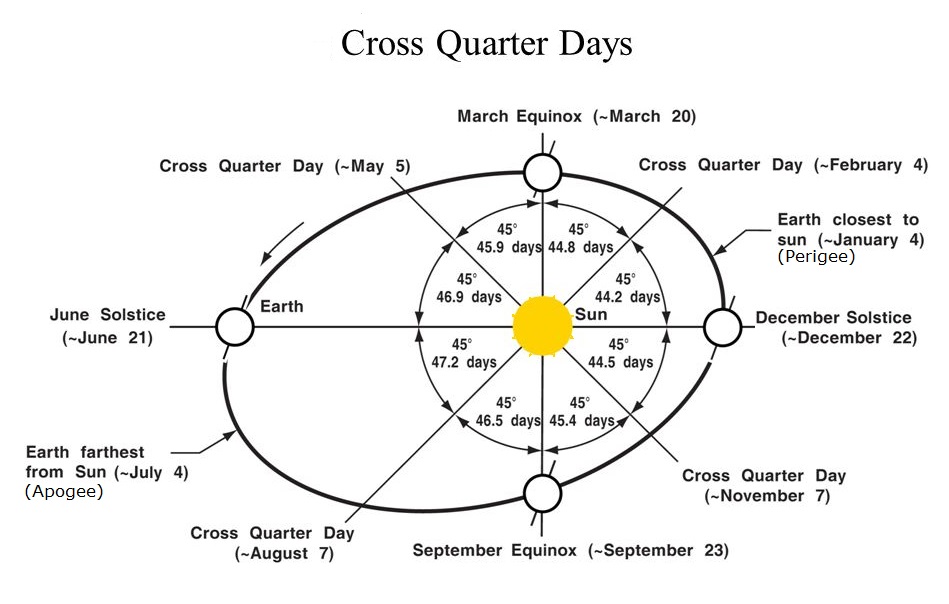
Groundhog Day has been observed since the 1880’s. It began as the German “Badger Day” observed on Candlemas, which is celebrated on February 2 by Roman Catholics. It marks the 40th and final day of the Christmas-Epiphany period. In contemporary paganism, the day is called Imbolc, a traditional time for initiations. Gaelics observe the traditional festival of Saint Brigid of Kildare. The other three cross-quarter days are May Day (Beltane) on May 1, and Lughnasath (Lammas) on August 1, and All Hallow’s Day (Samhain) on November 1. I think you can guess which spooky “holiday” that last one connects to. Anyway – I guess those of us in wintry climes should cross our fingers and hope for cloudy skies on Thursday.
Have you noticed that the sky is brighter at dinner time nowadays? At this time of year in mid-northern latitudes, the sun sets about 2 minutes later every night and rises a minute earlier in the morning – dramatically lengthening our daylight hours with each passing week.
The Moon
After a couple of moon-filled weeks, Earthlings worldwide will see a return to darker evening skies this week.
Tonight (Sunday) the bright, waning gibbous moon will rise around mid-evening, with the bright stars of Leo (the Lion) sparkling above it. With each passing night, the moon will decrease in illuminated phase and rise about an hour later. That means it will also linger longer into the daytime morning sky like a ghost of the night.
On Monday night the moon will begin a journey through the lengthy constellation of Virgo (the Maiden). After the moon rises in late evening on Tuesday night you can use it to guide you to the terrific double star named Porrima (or Gamma Virginis), which will be shining brightly to the moon’s upper left (or celestial north).
Binoculars will show that Porrima has some small companion stars near it, but a backyard telescope will split Porrima into a matched pair of white stars, like headlights of a car 38 light-years away. Those two stars are orbiting one another every 169 years in a true binary star system. Astronomers like my friend Blake Nancarrow make a point of viewing them every few years to measure how their arrangement varies in order to calculate their orbit. The two stars were closest together (at periapsis) in 2005, so they are widening a little more every year, making them easier to separate. Virgo shines in the early evening sky from April to June annually.
On Wednesday night the moon will shine even closer to Virgo’s brightest star Spica, a name arising from the Latin for “Ear of Wheat”. Spica is a hot, class-B star located 250 light-years away from us. The moon will finish its time in Virgo on Thursday night into Friday morning, and then move into next-door Libra (the Scales).
The moon will reach its third (or last) quarter phase at 6:18 pm EST, 3:18 pm PST, or 23:18 Greenwich Mean Time on Friday – though it won’t be above the horizon for observers in the Americas at that time. At this part of the lunar month, the moon appears half-illuminated, with its western hemisphere lit by the pre-dawn sun. It rises around midnight and sets around noontime. That will leave the evening sky moonless for about a week afterward.
For the coming weekend, you’ll be able to spot the waning crescent moon in the south and eastern sky before dawn. After the moon rises around 3 am local time on Sunday, February 4, it will be crossing the upright line of three medium-bright, white stars that make up the claws of Scorpius (the Scorpion). From top to bottom their names are Graffias (or Acrab), Dschubba, and Fang. They are also called Beta, Delta, and Pi Scorpii, respectively. Two fainter stars named Nu Scorpii and Rho Scorpii frame the trio. Scorpius’ brightest star, reddish Antares, will twinkle a palm’s width to the lower left of the moon and the claws stars.
The Planets
For the next week or so, you can seek out the relatively prominent dot of Saturn shining a short distance above the west-southwestern horizon at dusk. By the time it sets around 9 pm local time, the brightest stars of Aquarius (the Water-Bearer) that surround Saturn may appear, too – but telescope views of the planet will be less than ideal.
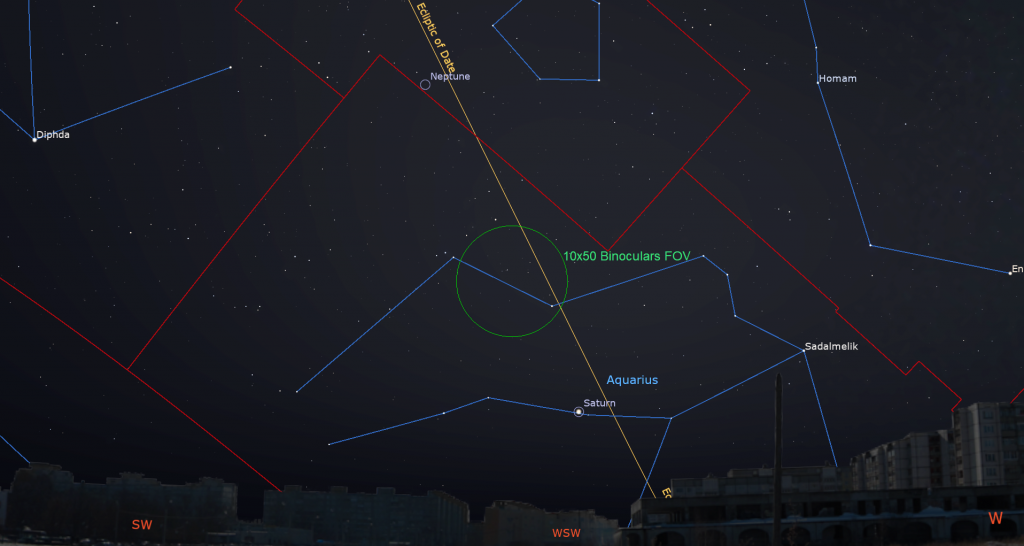
The imaginary line of the ecliptic stands almost upright over the southwestern horizon after sunset in winter, so the planets strung along it are carried downward before they set. The distant planet Neptune is nearly 20° to the east of Saturn along the ecliptic, so it will set about 100 minutes later than the ringed planet, and in a dark sky. Telescope views of magnitude 7.9 Neptune will be best before about 7:30 pm local time, while it is still a decent height in the sky. Search for the planet a short distance below the midway point between the medium-bright stars Diphda (or Beta Ceti) and Markab (or Alpha Pegasi). You can also use binoculars to find the circlet of stars marking the western fish of Pisces and then park the star Lambda Piscium, the leftmost star in that ring, at the upper right corner of your binoculars’ field of view. Bluish Neptune will then be at the lower left corner of the view.
In contrast with Neptune, Jupiter will be a breeze to spot every night. The brilliant planet will emerge high in the southern sky after dusk and then sink westward to set after midnight. The best telescope-viewing time will be as soon as you can spot it. Bright planets can show more detail in a twilight sky. The planet will look great under magnification until about 11 pm local time.
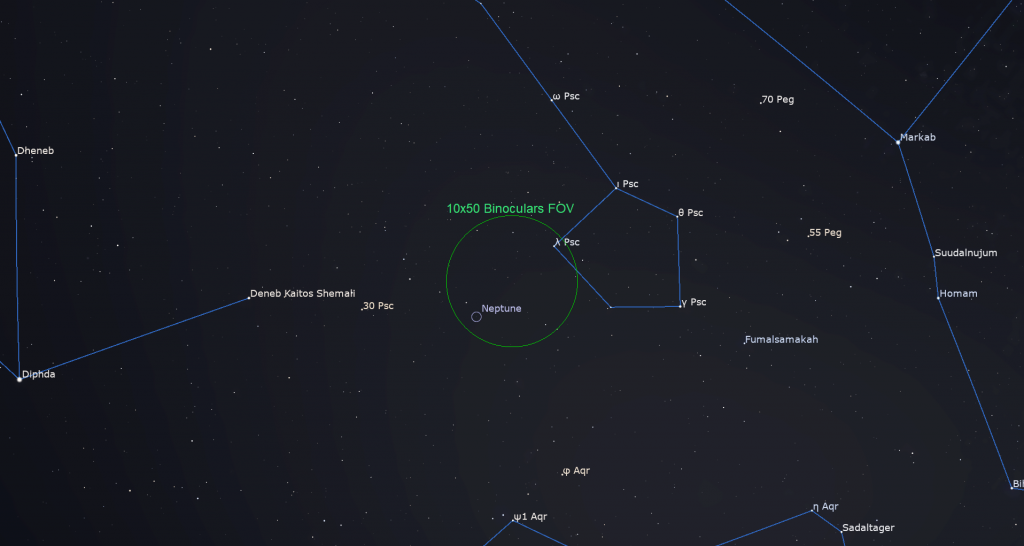
Any decent pair of binoculars can show you Jupiter’s four largest Galilean moons lined up on both sides of the planet. Named Io, Europa, Ganymede, and Callisto in order of their orbital distance from Jupiter, those moons complete orbits of the planet every 1.7, 3.6, 7.2, and 16.7 days, respectively. If you see fewer than four moons, then one or more of them is crossing in front of or behind Jupiter, or hiding in Jupiter’s dark shadow – or two of the moons are very close together or occulting one another. In the Americas, the moons will flank Jupiter in pairs this evening (Sunday) and next Sunday, show only two of them on Monday, and all gather to Jupiter’s east on Friday.
Any small telescope can show you Jupiter’s dark belts and light zones, which are aligned parallel to its equator. With a better grade of optics, Jupiter’s Great Red Spot, a cyclonic storm that has raged for hundreds of years, is visible for several hours when it crosses the planet every 2nd or 3rd night. For observers in the Americas, the GRS will cross Jupiter’s disk in mid-evening Eastern Time tonight (Sunday), Friday, and next Sunday. It’ll appear late on Tuesday, Thursday, and next Sunday night. The spot has been rather a pale pink in colour for some time now. If you have any coloured filters or nebula filters for your telescope, try enhancing the spot with them.
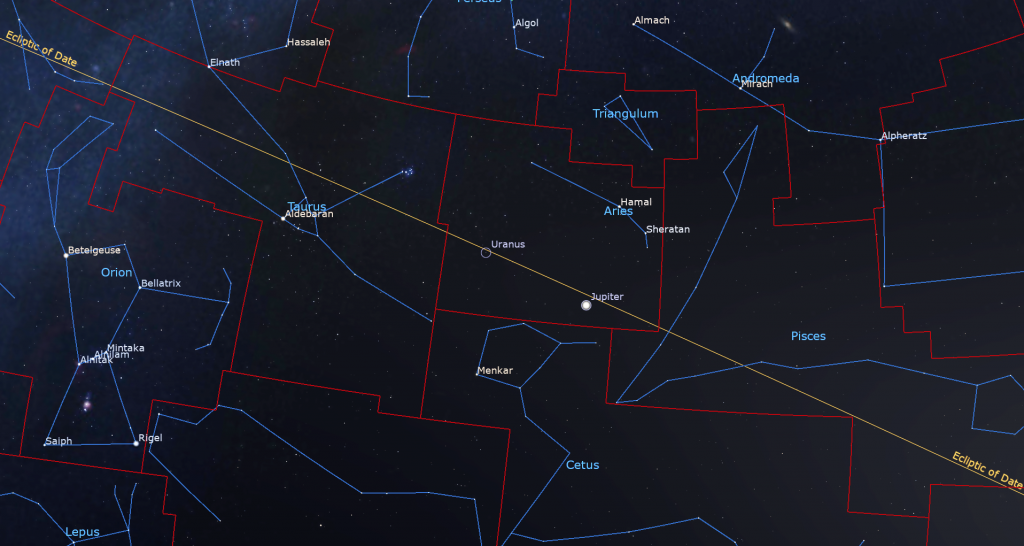
From time to time, the small, round, black shadows cast by Jupiter’s Galilean moons become visible in amateur telescopes when they cross (or transit) the planet’s disk. For those in the Americas, Io’s shadow will cross Jupiter on Sunday, January 28 from 10:07 pm to 12:10 am EST (or 03:07 to 05:10 GMT on Monday). (These times may vary by a few minutes, and other time zones of the world will have their own crossings.)
Uranus is wandering through southeastern Aries (the Ram), an hour behind Jupiter on the ecliptic. So it will set around 2 am local time. Magnitude 5.7 Uranus is quite easy to see in binoculars and backyard telescopes in dark, moonless skies. This week, the blue-green planet’s speck will be positioned 1.2 fist diameters to Jupiter’s upper left (or 12° to its celestial ENE). The bright Pleiades star cluster will be sprinkled a generous fist’s width above Uranus (or 11.8° to its celestial northeast). For even more help, the three bright stars of Orion’s Belt are aimed at Uranus.
The rest of the planets are gathered above the southeastern sky before sunrise.
Brilliant Venus, which rises first at about 5:45 am local time, is rapidly swinging toward the sun, shortening its viewing time with each passing day. This week Venus will travel eastward through northern Sagittarius (the Archer) by more than an outstretched palm’s width. Venus will be a gleaming point of light until sunrise. A telescope or strong binoculars will reveal that Venus has a rugby ball shape.
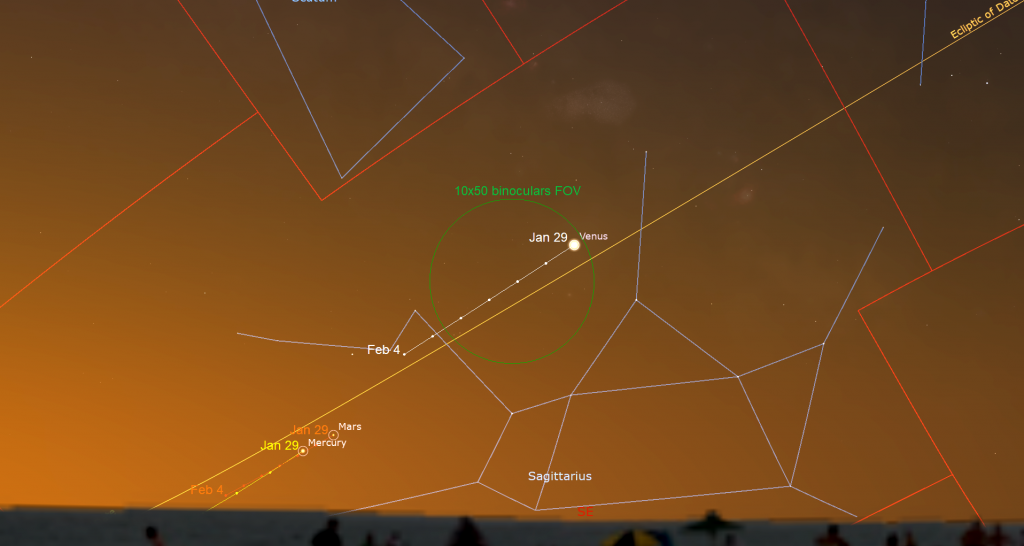
As this week begins, Mercury and fainter Mars will be paired up above the southeastern horizon just before sunrise. The duo will be positioned a fist’s diameter (or 11° to) the lower left of Venus. On Monday morning, Mars will be located a finger’s width to Mercury’s upper right (or celestial west). Mercury will widen their gap due to its shift sunward each morning. Observers viewing from near the tropics will more easily see Venus, Mercury, and Mars. Remember that your optics may flip and/or invert the scene, and be sure to turn all optics away from the horizon before the sun rises.
Eyeing Orion
Every year during winter, the southern evening sky is dominated by the eye-catching constellation of Orion (the Hunter) and his famous three-starred belt. Orion contains some of the sky’s most spectacular sights – whether you are using your unaided eyes, binoculars, or telescopes of any size! Orion’s spectacular stars, and the bright nebulas in his sword and belt, make cold winter nights much more rewarding for skywatchers. The moon will be out of the evening sky for a while starting this weekend, so let’s bundle up against the winter chill and take a tour of the hunter!
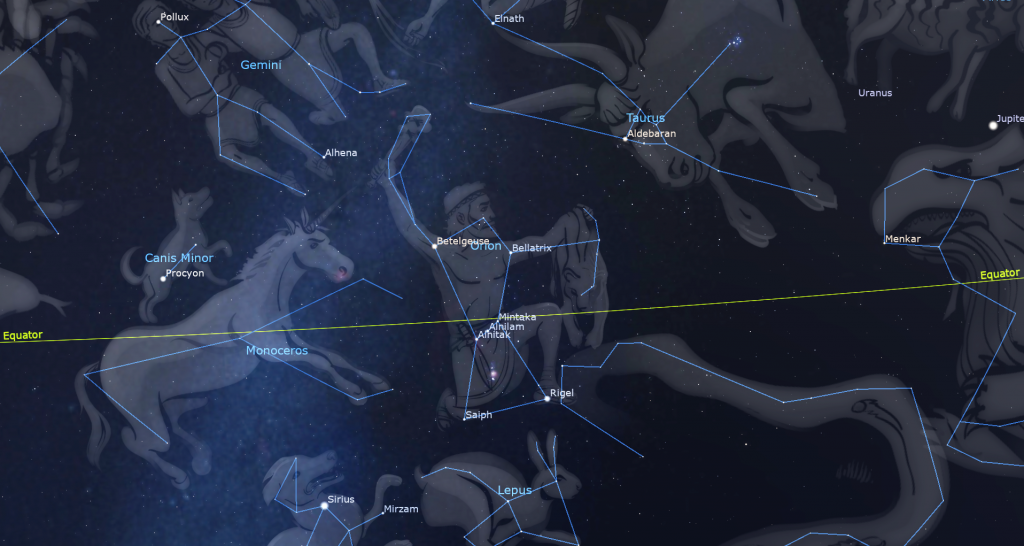
The constellation of Orion is well-known for several reasons. It straddles the Celestial Equator, making it visible from both the Northern and Southern Hemispheres. Most of its stars are bright enough to see with unaided eyes, even under light-polluted skies. And the constellation obviously represents a human figure.
Orion is surrounded by Taurus (the Bull) to his upper right (celestial northwest), Gemini (the Twins) to his upper left (northeast), Monoceros (the Unicorn) on his left (east), Lepus (the Rabbit) below him (south), and Eridanus (the River) towards his lower right (southwest).
He has traditionally been depicted as kneeling. His eastern arm is raised and holds a club. His western arm is outstretched, and his hand holds a lion’s pelt, or a shield. Orion is a medium-sized constellation measuring about 30° (or three outstretched fist widths) from the tip of his club to his toes or knees, and 20° from his eastern elbow to the lion’s pelt. In early evening in late February, Orion is halfway up the southern sky, his head tilted a little to the right for observers viewing him in the Northern Hemisphere. As the evening wears on, Orion drops lower and tips over more, then he sets at about 1:30 am local time.

The constellation was recorded by Babylonians as the Heavenly Shepherd (where his club is a crook). The Egyptians added the stars of Lepus to form the god Sah, which was associated with the deity representing the star Sirius. The muslims called him “al-jabbar” the giant. The Polynesians saw a Cat’s Cradle game in Orion’s stars. The Maori incorporated Orion’s belt into the stern of their great ocean-going canoe, Te Waka O Tamarereti.
In Greek mythology, Orion was Prion the hunter, the son of Poseidon. When Prion threatened to hunt and kill all the animals in the world, Earth-mother Gaia sent Scorpius to sting him to death. But Ophiuchus (the Water-Bearer) used medicine to save Prion. Now, Orion and Scorpius sit on opposite sides of the sky. Orion is in the winter evening sky and Scorpius is in the winter morning sky – with Ophiuchus stepping on the scorpion from above. Orion is mentioned several times in the Bible, and as Menelvagor “the Swordsman of the Sky” in J. R. R. Tolkien’s Lord of the Rings.
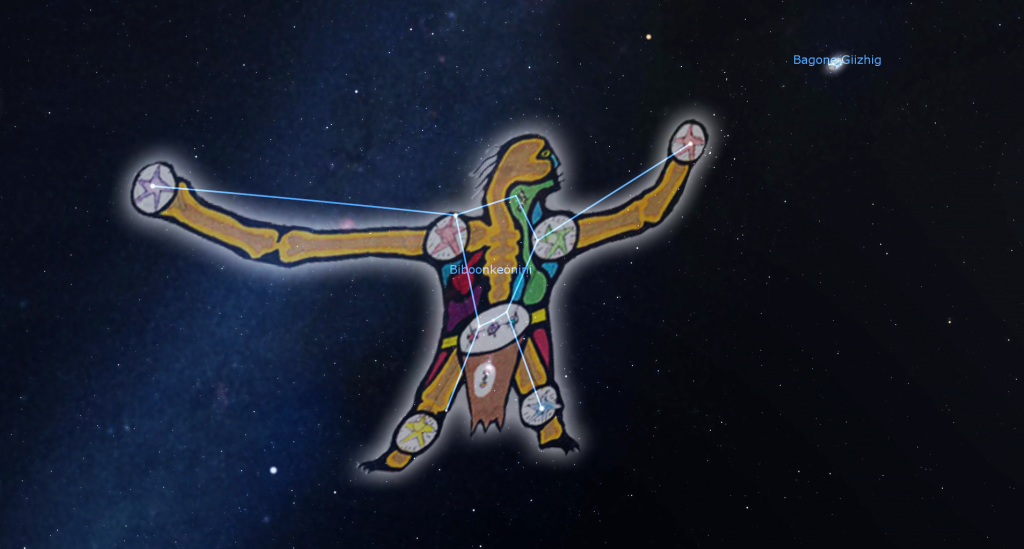
The Ojibwe and related indigenous groups of North America associate Orion’s stars with the constellation of Biboonikeonini (”Bih-BOON-koh-nih-NIH”), the Winter-Maker. They envision him with longer arms – so that his hands hold the bright stars Procyon on the east and Aldebaran on the west.
Not surprisingly, many cultures have also assigned meaning to the distinctive row of three regularly spaced stars that mark Orion’s Belt. Scandinavian countries have seen a distaff, a scythe, and a sword. Predominantly Catholic countries referred to those three stars as The Three Mary’s (as featured in the New Testament). In the Middle East, his belt has been identified as The Three Kings or Magi. In China, it is known as The Weighing Beam and the Three Stars. In fact, the top portion of the Chinese character, 參 (shēn) has three identical symbols representing those three stars. The Lakota people called his belt the Bison’s Spine – with surrounding stars and nearby constellations forming the rest of a great bison in their winter sky. When viewed from the Southern Hemisphere, Orion is upside-down. His belt and sword combine to form the shape of a frying pan! Try bending over and looking at him upside-down.
From left to right (or east to west in the Northern Hemisphere), the three belt stars are named Alnitak, Alnilam, and Mintaka. While they appear similar, Alnitak is bluer, Mintaka is dimmer, and Alnilam is MUCH farther away.
In a telescope, Alnitak (Arabic for “the Girdle”) is revealed to be a very tight double star. The larger, main star of Alnitak’s pair is a blue supergiant star located about 820 light-years from our solar system. The star emits tremendous amounts of ultraviolet light. Its surface temperature is a scorching 31,000 Kelvins, which is essentially the same as 31,000° C at those extremes! For comparison, our little yellow sun’s temperature is a mere 6,200 K! Alnitak’s dimmer partner is orbiting the main star once every 1,500 years!
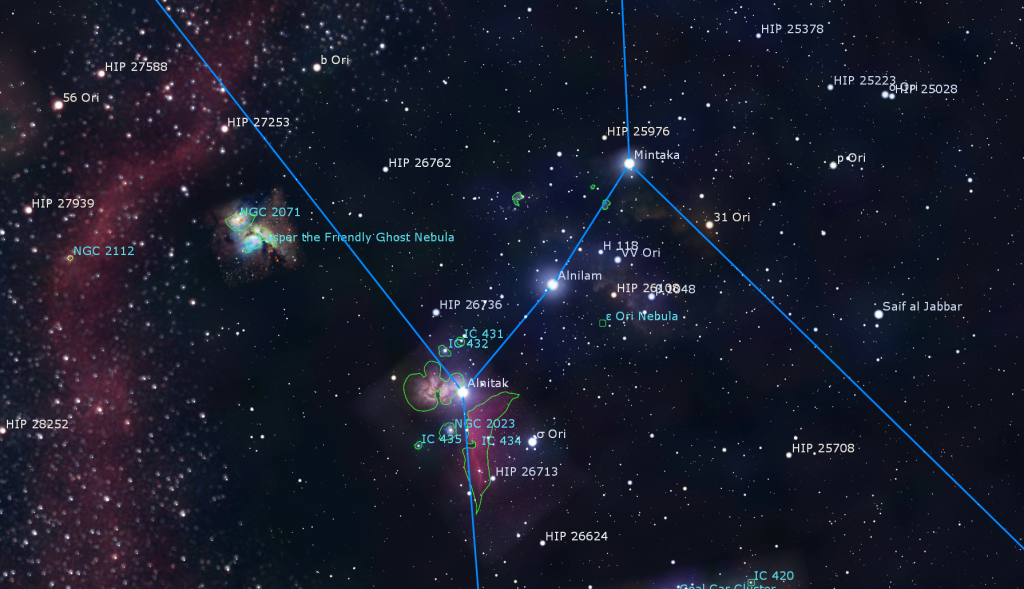
The belt’s middle star, Alnilam (“String of Pearls”), is another large and very hot, blue-white star. It’s located about twice as far away from us than the two other belt stars. Aging rapidly and nearing the end of its hydrogen supply, Alnilam is expected to become a red supergiant, the pre-cursor to a supernova blast, at any time. And since the star is more than 1,900 light years away from us – that explosion may already have happened!
The belt’s westernmost star, called Mintaka (“Belt”), is also a double star when viewed in a telescope. In fact, there are at least four stars making up what we see as Mintaka. The brightest one has a partner that orbits it in an eclipsing binary configuration that causes the star to vary in brightness for 18 hours every 5.73 days. The dominant stars in Mintaka’s family gathering are hot, blue giants. The group is located about 900 light years away from our solar system. If you look carefully, Mintaka is actually quite a bit dimmer than Alnitak and Alnilam. At the same time, look for a large, upright letter-S shape composed of dim stars in the space between Alnilam and Mintaka.
The bright, orange-coloured star named Betelgeuse marks Orion’s eastern armpit or shoulder. That funny-sounding name comes from the Arabic expressions “Ibṭ al-Jauzā”, meaning “the Armpit of Jauza”, or “Yad al-Jauzā”, “the Hand of Jauza”. Jauza was the Arabic name for the person the Arabs saw depicted in the Orion constellation. In Chinese, Betelgeuse is called 参宿四 Sānsù Sì, which translates to “The Fourth Star of the constellation of Three Stars”.
Betelgeuse is a red supergiant star located about 500 light-years away. If Betelgeuse replaced the sun in our solar system, all the inner planets out to Mars would be inside the star! Despite an age much less than our sun (it is of a type that matures dramatically faster), astronomers think Betelgeuse is approaching the end of its life. It is massive enough to explode as a Type II Supernova.
Normally, Betelgeuse ranks as the ninth brightest star in all the night sky. But in the winter of 2019-2020 it dimmed dramatically. While Betelgeuse has been known to dim and brighten throughout the many years that astronomers have been recording its brightness, this recent dimming was far below what is typically observed. Some thought we might be seeing indications that the end is near. After several months, it recovered most of its brightness. Astronomers now theorize that an encircling cloud of opaque dust temporarily passed in front of the star, dimming its light. Since it takes about 500 years for light to reach us from Betelgeuse, it could already have exploded! If it does blow up, Earth is in no danger. We’ll just be treated to a spectacularly bright point of light for days or weeks.
The hot blue star sitting to the lower right (or southwest) of Orion’s belt is Rigel. Despite being located much farther away from us (about 860 light-years), Rigel is usually approximately the same visual brightness as Betelgeuse – meaning that Rigel emits considerably more visible light than Betelgeuse. Astronomers call this phenomena high luminosity. Rigel, too, is a supergiant star, and it has a surface temperature of 11,000 K! In a good telescope, a small companion star can be spotted very close beside Rigel. In Arabic, Rigel means “the Foot of the Great One”. In China, Rigel is known as 参宿七 (Sānsù Qī), “The Seventh of the Three Stars”.
Orion’s western shoulder is marked by the bright star Bellatrix, which translates as “Amazon Star”, after the warrior women of legend. Bellatrix is about 250 light years away from us, and burns at a blistering hot 21,500 K. It, too, is well along in its life cycle, and is expected to soon enter its next phase of evolution and turn an orange colour.
Above and between Orion’s shoulders is an open cluster of stars, 1,305 light-years distant, that forms his head. The brightest star in the group is named Meissa (“the Shining One”). Use binoculars or a telescope to enjoy them better, and see how many stars you can count. And try to magnify Meissa more to see its close partner. Some star charts call the cluster the Lambda Orionis Cluster, after Meissa’s Bayer designation.
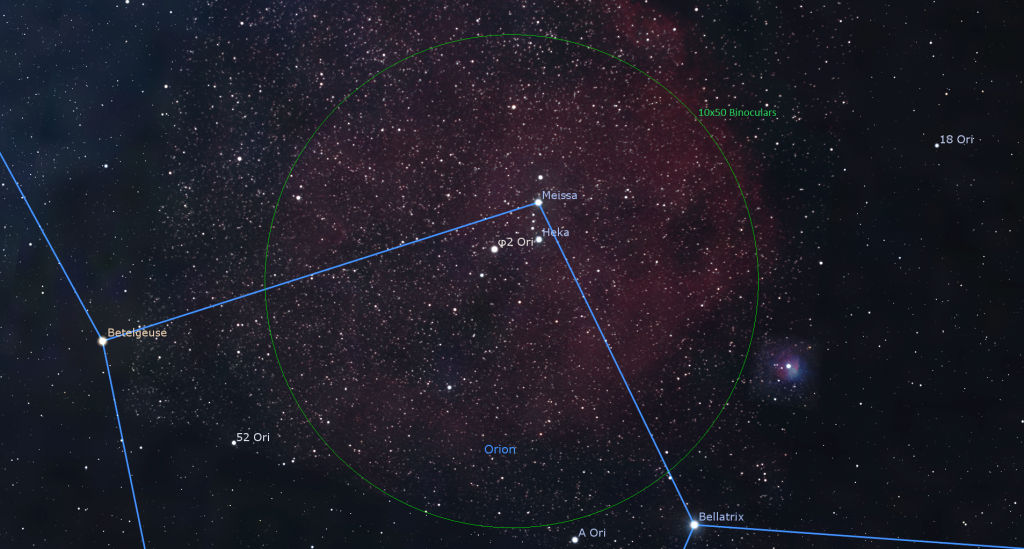
Completing our circuit of Orion’s main body, the western foot or knee of Orion is the mis-named star Saiph or “Sword of the Giant”. Saiph is another hot, blue white star, with a surface temperature of 26,500 K, and it is also approaching the transition to creaky, old, red supergiant.
The lion’s pelt, or shield, that Orion is holding is composed of a crooked line of stars that run up and down off to Orion’s right-hand (or western) side. The brightest star, in the middle of the string, is named Tabit (“the Endurer”). This star’s Bayer designation is Pi Orionis. In fact, the entire set of stars are named π1 through π6 Orionis.
On the opposite side of the constellation, Orion’s upraised club dips into the Milky Way. As you move up the club, the pairs of stars that define it move wider apart. Use your binoculars to reveal the rich Milky Way star fields there.
We can use Orion’s stars as pointers to other ones. Extending the belt stars to the west leads to the bright, orange-ish star Aldebaran in Taurus, the Bull. Heading two fist diameters in the opposite direction leads you to the “Dog-star” Sirius, the brightest star in the entire night sky. A line drawn from Bellatrix to Betelgeuse points to Sirius’ bright puppy, the star Procyon. Finally, the line extending from Rigel up through Betelgeuse leads to the two matched stars Castor and Pollux, the heads of Gemini (the Twins).

Orion’s spectacular sword is one of winter’s true astronomical treats. The sword is located a few finger widths below Orion’s belt. Unaided eyes can generally detect three patches of light in Orion’s sword, but binoculars or a telescope will reveal that the middle object is not a single star at all, but a bright knot of glowing gas and stars known as The Orion Nebula (or the Great Nebula in Orion, Messier 42, and M42).
The Orion Nebula is one of the brightest nebulae in the entire night sky and, at 1,400 light-years from Earth, it is one of the closest star-forming nurseries to us. It’s enormous. Under a very dark sky, the nebula can be traced over an area equivalent to four full moons! When you see knots of pink color in photos of other galaxies, you are seeing objects like M42.
Buried in the core of the Orion Nebula is a tight clump of stars collectively designated Theta Orionis (Orionis is Latin for “of Orion”), but better known as the Trapezium – because the brightest four stars occupy the corners of a trapezoid shape. Even a small telescope should be able to pick out this four-star asterism – but good seeing conditions and a larger aperture telescope will reveal two additional faint stars in the trapezium. The trapezium stars are hot, young O- and B-type stars that are emitting intense amounts of ultraviolet radiation. The radiation causes the Hydrogen gas they are embedded within to shine brightly as red light. At the same time, some of their light is scattered by surrounding dust, producing blue light. The combination of red and blue is why there is so much purple and pink in colour images of the nebula.
Within the nebula, astronomers have detected many young (about 100,000 years old) concentrations of collapsing gas called proplyds that should one day form solar systems. These objects give us a glimpse into how our own sun and planets formed.
Stargazers have long known about the trapezium stars in the nebula’s core, but detection of the nebulosity around them required the invention of telescopes in the early 1600’s. In the 1700’s, Charles Messier and Edmund Halley (both famous comet observers) noted the nebula in their growing catalogues of “fuzzy” objects. In 1880, amateur astronomer Henry Draper imaged the nebula through an 11-inch refractor telescope, making it the first deep sky object to be photographed.

In your own small telescope, you should see the bright clump of trapezium stars surrounded by a ghostly grey shroud, complete with brighter veils and darker gaps. More photons would need to be delivered to your retina before colour would be observed, so try photographing it through your telescope, or using a camera/telephoto lens combination mounted on a tripod. Visually, start with low magnification and enjoy the extent of the cloud before zooming in on the tight asterism. Can you see four stars, or more? Just to the upper left of M42, you’ll find Messier 43, a separate lobe of the same nebula that has been separated by a band of opaque foreground dust. M43 surrounds a naked-eye star named Nu Orionis (or ν Ori).
While you’re touring the sword, look just below the nebula for a loose group of stars, located 1,300 light-years away from Earth, called Nair al Saif “the Bright One of the Sword”. The main star is a hot, bright star expected to explode in a supernova one day. It, too is surrounded by faint nebulosity. Astronomers believe that this star was gravitationally kicked out of the Hyades Cluster in Taurus about 2.5 million years ago.
Sweeping down the sword and toward the left (east) brings us to a star named Mizan Batil ath Thaalith (or d Orionis or 49 Orionis) at the tip of the sword. This magnitude 4.7 star is near the limit for unassisted visibility under moonless, suburban skies. About two finger widths to its right is another star of similar brightness, named Upsilon Orionis, or u Ori.
Moving upwards towards Orion’s belt, look half a finger’s width (or 30 arc-minutes – equal to the full moon’s diameter) above the Orion Nebula. Here you’ll find another clump of stars dominated by c Orionis and 45 Orionis. A larger telescope, or a long-exposure photograph, will reveal a bluish patch of nebulosity around them that contains darker lanes forming the shape of a figure, called the Running Man Nebula (NGC 1977). This is another case of dust and gas scattering blue light from those two stars.
Just above the Running Man sits a loose cluster of a few dozen stars called the Coal Car Cluster, or NGC 1981. It’s best seen in binoculars. Next, we jump higher – most of the way towards Alnitak, the eastern-most (left-hand) belt star, to check out a beautiful little grouping of stars collectively called Sigma Orionis (σ Ori). What makes this a special treat is that, in a small telescope, we find about 10 stars the grouping. Check it out with your telescope – trust me, it’s a pretty sight! It’s a bit more than a finger’s width to the lower right of Alnitak.
Astrophotographers love to image the area around Alnitak because it sits just to the west (or right-hand side) of the Milky Way, and is loaded with gorgeous gas clouds and nebulae. Alnitak and the brighter stars around it all host reflection nebulae – dim bluish haloes caused by starlight scattering off of dust.
Immediately below (south of) Alnitak is the famous Horsehead Nebula (or NGC 2023). It’s a cloud of hydrogen that is being energized by radiation from Alnitak, producing an elongated wedge of red light in long exposure images. A foreground patch of opaque dust that forms a delightful sea-horse or chess-piece shaped silhouette on the nebula’s (left-hand) eastern edge. It’s not readily visible – unless you have very dark skies and a very large aperture telescope.
Just to the left of Alnitak is another object called the Flame Nebula, also known as the Maple Leaf Nebula, the Burning Bush Nebula, and NGC 2024. More energetic radiation from Alnitak is causing gas to glow. But this time, there’s a lot of dark dust mixed in, producing a unique shape.
Several bright emission nebulae are clumped about two finger widths to the upper left (or celestial north) of Alnitak. The brightest of these is Messier 78, the Casper the Friendly Ghost Nebula. The young stars buried within the gas and dust are producing the pinkish emissions and bluish reflections. Another similar object called the Monkey Head Nebula (or NGC 2175) sits way up beside the tip of Orion’s club.
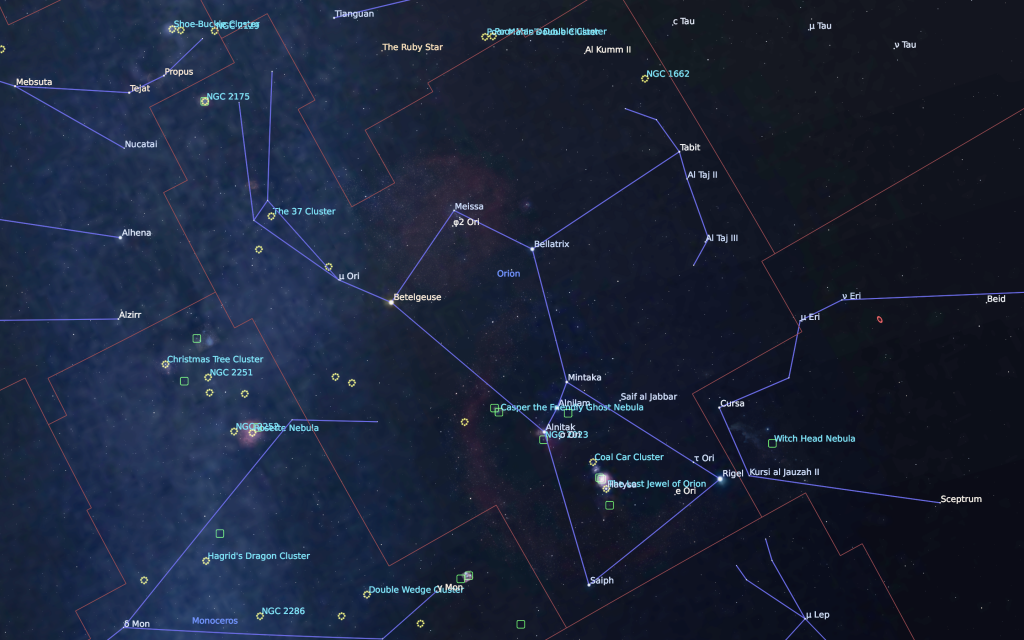
Orion’s upraised club starts at reddish Betelgeuse, continues through medium-bright Mu Orionis, and then widens north of the magnitude 4.5 stars Xi and Nu Orionis. A delightful open cluster named NGC 2169 is positioned between those stars, but offset a little towards Betelgeuse. Shining at magnitude 5.9, the cluster might look like a double star in your binoculars. In any size of telescope look for a dozen stars sparkling within a compact area. They are arranged in two groups that appear to form the letters “LE” or the number “37” or a shopping cart. Your own impression may depend upon how your telescope orients the cluster. I noted several doubles and some nice variation in the star colours.
A very nice open cluster designated NGC 1662 is located a thumb’s width to the right (or 1.6° to the celestial WNW) of Pi1 Orionis, the top star in Orion’s shield. The magnitude 6.4 cluster should be visible as a small patch in 10×50 binoculars. In any size of telescope, look for a tiny, diamond-shaped asterism flanked by a row of blue and yellow stars. It resembles a bird riding an air current, or maybe the lights of a Klingon battle cruiser. No danger, though – it is 1,450 light-years away from our sun.
Have a look. I think you’ll agree that Orion is indeed a celestial treat for everyone to enjoy!
Seeing Double in January
If you missed last week’s guide to the double (or triple) stars available in evening this time of year, I post sky charts for them here.
Public Astronomy-Themed Events
Every Monday evening, York University’s Allan I. Carswell Observatory runs an online star party – broadcasting views from four telescopes/cameras, answering viewer questions, and taking requests! Details are here. They host in-person viewing on the first clear Wednesday night each month. Other Wednesdays they stream views online via the observatory YouTube channel. Details are here.
On Friday, February 2 from 6:30 pm to 8:30 pm, RASC Toronto Centre will host Family Night at the David Dunlap Observatory for visitors aged 7 and up. You will tour the sky, visit the giant 74” telescope, and view celestial sights through telescopes if the sky is clear. This program runs rain or shine. Details are here, and the link for tickets is here.
On Saturday, February 3 from 10 am to noon, you can try out Solar Observing at the Ontario Science Centre! If it’s sunny, members of the RASC Toronto Centre will be setting up outside on the Teluscape in front of the main doors. They’ll have an array of special equipment designed to view the Sun safely. This is free to the public, but parking and admission fees inside the Science Centre will still apply. Check the RASC Toronto Centre website or their Facebook page for the Go or No-Go notification.
Keep your eyes on the skies! I love getting questions and requests. Send me some!